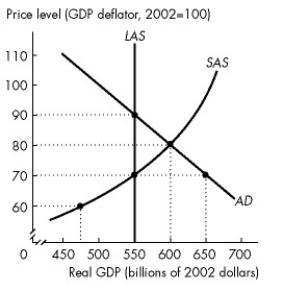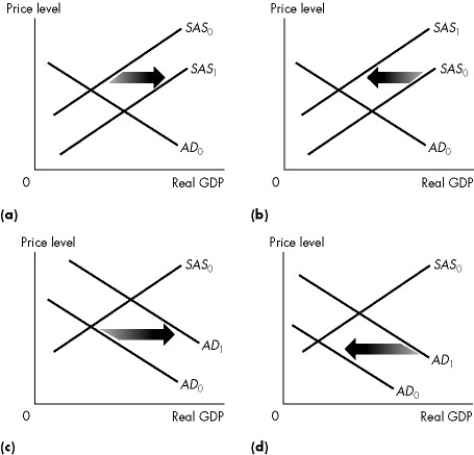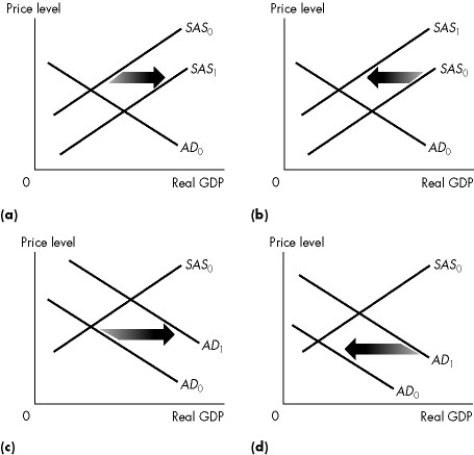A) "The decrease in consumer spending may lead to a recession."
B) "The increase in consumer spending is expected to lead to inflation, without any increase in real GDP."
C) "Recent higher wage settlements are expected to cause higher inflation this year."
D) "Growth has been unusually high the last few years due to more women entering the work force."
E) "The recent tornadoes destroyed many factories in Calgary and Edmonton."
Correct Answer

verified
Correct Answer
verified
Multiple Choice
The quantity of real GDP demanded does not depend on decisions made by
A) foreigners.
B) households.
C) suppliers.
D) governments.
E) firms.
Correct Answer

verified
Correct Answer
verified
Multiple Choice
Consider an economy starting from a position of full employment. Which one of the following changes does not occur as a result of a decrease in aggregate demand?
A) The price level decreases.
B) The level of real GDP decreases in the short run.
C) A recessionary gap arises.
D) Factor prices decrease in the long run, shifting the short-run aggregate supply curve rightward.
E) The long-run aggregate supply curve shifts leftward to create the new long-run equilibrium.
Correct Answer

verified
Correct Answer
verified
Multiple Choice
Autoworkers agree to a cut in the nominal wage rate. This event ________ short-run aggregate supply and ________ long-run aggregate supply.
A) does not change; does not change
B) decreases; does not change;
C) increases; does not change;
D) increases; increases
E) decreases; does not change
Correct Answer

verified
Correct Answer
verified
Multiple Choice
Use the figure below to answer the following questions.
 Figure 26.3.2
-Refer to Figure 26.3.2. If the economy of Mythlo automatically adjusts to long-run equilibrium, then
Figure 26.3.2
-Refer to Figure 26.3.2. If the economy of Mythlo automatically adjusts to long-run equilibrium, then
A) the price level rises to 90.
B) real GDP is $600 billion.
C) the actual unemployment rate exceeds the natural unemployment rate.
D) potential GDP decreases.
E) the SAS curve shifts rightward.
Correct Answer

verified
Correct Answer
verified
Multiple Choice
If real GDP is greater than potential GDP, we would expect
A) the money wage rate to fall.
B) the money wage rate to rise.
C) potential GDP to increase.
D) potential GDP to decrease.
E) the expected future inflation rate to decrease.
Correct Answer

verified
Correct Answer
verified
Multiple Choice
Suppose that the E.U. economy goes into an expansion. Canadian real GDP ________ and Canadian unemployment ________ in the short run.
A) increases; decreases
B) increases; increases
C) decreases; decreases
D) decreases; increases
E) does not change; does not change
Correct Answer

verified
Correct Answer
verified
Multiple Choice
Which one, if any, of the following events shift the short-run aggregate supply curve but not the long-run aggregate supply curve?
A) a change in factor prices
B) a change in the quantity of capital
C) an advance in technology
D) an increase in the full-employment quantity of labour
E) none of the above
Correct Answer

verified
Correct Answer
verified
Multiple Choice
If real GDP is greater than potential GDP, the economy is
A) not in short-run equilibrium.
B) in a recessionary equilibrium.
C) in an above full-employment equilibrium.
D) in a below full-employment equilibrium.
E) in long-run equilibrium.
Correct Answer

verified
Correct Answer
verified
Multiple Choice
Classical macroeconomists recommend
A) policies that actively offset changes in long-run aggregate supply that result in negative economic growth.
B) an increase in the quantity of money to offset decreases in aggregate demand and a decrease in the quantity of money to offset increases in aggregate demand.
C) policies that actively offset changes in aggregate demand that bring recession.
D) policies that minimize the disincentive effects of taxes on employment, investment, and technological change.
E) all of the above
Correct Answer

verified
Correct Answer
verified
Multiple Choice
Use the figure below to answer the following questions.
 Figure 26.3.2
-Refer to Figure 26.3.2. Currently in Mythlo
Figure 26.3.2
-Refer to Figure 26.3.2. Currently in Mythlo
A) there is a below full-employment equilibrium.
B) the actual unemployment rate is less than the natural unemployment rate.
C) potential GDP is greater than equilibrium GDP.
D) the actual unemployment rate is equal to the natural unemployment rate.
E) there is a recessionary gap.
Correct Answer

verified
Correct Answer
verified
Multiple Choice
Use the figure below to answer the following questions.
 Figure 26.2.1
-Refer to Figure 26.2.1. Which graph illustrates what happens when expected future income increases?
Figure 26.2.1
-Refer to Figure 26.2.1. Which graph illustrates what happens when expected future income increases?
A) (a) only
B) (b) only
C) (c) only
D) (d) only
E) Both (a) and (c)
Correct Answer

verified
Correct Answer
verified
Multiple Choice
Use the figure below to answer the following questions.
 Figure 26.1.1
-Refer to Figure 26.1.1. Which graph illustrates what happens when factor prices decrease?
Figure 26.1.1
-Refer to Figure 26.1.1. Which graph illustrates what happens when factor prices decrease?
A) (a)
B) (b)
C) (c)
D) (d)
E) (a) and (b)
Correct Answer

verified
Correct Answer
verified
Multiple Choice
The world goes into an expansion. Starting from a position of long-run equilibrium, what effect does this event have on Canada's economy in the short run?
A) Real GDP increases and the price level rises.
B) Real GDP decreases and the price level falls.
C) Real GDP increases and the price level falls.
D) Real GDP decreases and the price level rises.
E) There is no change in either real GDP or the price level.
Correct Answer

verified
Correct Answer
verified
Multiple Choice
Which of the following statements about the Keynesian view of the macroeconomy is incorrect?
A) Technological change is the most significant influence on both aggregate demand and aggregate supply.
B) To achieve and maintain full employment, active help from fiscal policy and monetary policy is required.
C) Expectations are based on "animal spirits."
D) The money wage rate is extremely sticky in the downward direction so there is no automatic mechanism for eliminating a recessionary gap.
E) Expectations are the most significant influence on aggregate demand.
Correct Answer

verified
Correct Answer
verified
Multiple Choice
Everything else remaining the same, an increase in the expected inflation rate
A) shifts the aggregate demand curve rightward.
B) shifts the aggregate demand curve leftward.
C) shifts the short-run aggregate supply curve leftward.
D) shifts the long-run aggregate supply curve rightward.
E) creates a movement up along the aggregate demand curve.
Correct Answer

verified
Correct Answer
verified
Showing 121 - 136 of 136
Related Exams